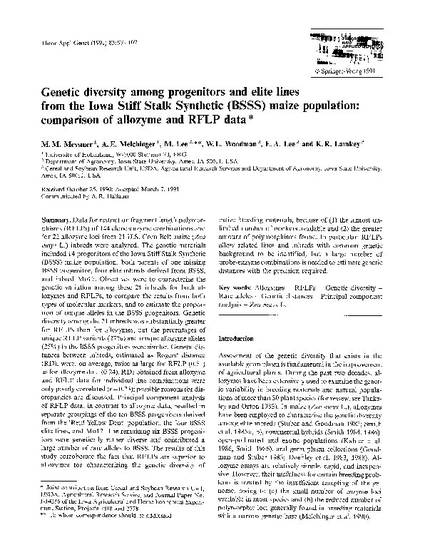
Data for restriction fragment length polymorphisms (RFLPs) of 144 clone-enzyme combinations and for 22 allozyme loci from 21 U.S. Corn Belt maize (Zea mays L.) inbreds were analyzed. The genetic materials included 14 progenitors of the Iowa Stiff Stalk Synthetic (BSSS) maize population, both parents of one missing BSSS progenitor, four elite inbreds derived from BSSS, and inbred Mo17. Objectives were to characterize the genetic variation among these 21 inbreds for both allozymes and RFLPs, to compare the results from both types of molecular markers, and to estimate the proportion of unique alleles in the BSSS progenitors. Genetic diversity among the 21 inbreds was substantially greater for RFLPs than for allozymes, but the percentages of unique RFLP variants (27%) and unique allozyme alleles (25%) in the BSSS progenitors were similar. Genetic distances between inbreds, estimated as Rogers' distance (RD), were, on average, twice as large for RFLP (0.51) as for allozyme data (0.24). RDs obtained from allozyme and RFLP data for individual line combinations were only poorly correlated (r = 0.23); possible reasons for discrepancies are discussed. Principal component analysis of RFLP data, in contrast to allozyme data, resulted in separate groupings of the ten BSSS progenitors derived from the ‘Reid Yellow Dent’ population, the four BSSS elite lines, and Mo17. The remaining six BSSS progenitors were genetically rather diverse and contributed a large number of rare alleles to BSSS. The results of this study corroborate the fact that RFLPs are superior to allozymes for characterizing the genetic diversity of maize breeding materials, because of (1) the almost unlimited number of markers available and (2) the greater amount of polymorphisms found. In particular, RFLPs allow related lines and inbreds with common genetic background to be identified, but a large number of probe-enzyme combinations is needed to estimate genetic distances with the precision required.
Available at: http://works.bepress.com/kendall_lamkey/48/

This article is published as Messmer, M. M., A. E. Melchinger, M. Lee, W. L. Woodman, E. A. Lee, and K. R. Lamkey. "Genetic diversity among progenitors and elite lines from the Iowa Stiff Stalk Synthetic (BSSS) maize population: comparison of allozyme and RFLP data." Theoretical and applied genetics 83, no. 1 (1991): 97-107. doi:10.1007/BF00229231. Posted with permission.